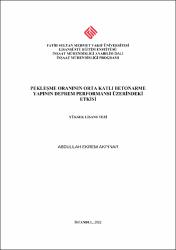Pekleşme Oranının Orta Katlı Betonarme Yapının Deprem Performansı Üzerindeki Etkisi
Künye
AKPINAR, Abdullah Ekrem, Pekleşme Oranının Orta Katlı Betonarme Yapının Deprem Performansı Üzerindeki Etkisi, Fatih Sultan Mehmet Vakıf Üniversitesi Lisansüstü Eğitim Enstitüsü İnşaat Mühendisliği Anabilim Dalı İnşaat Mühendisliği Programı, Yayımlanmamış Yüksek Lisans Tezi, İstanbul 2022.Özet
Türkiye Bina Deprem Yönetmeliği 2018’de betonarme taşıyıcı sistemlerin şekildeğiştirmeye göre değerlendirmelerinde kiriş ve kolon elemanlarının uç noktalarında plastik mafsal modelinin tanımlanmasında kullanılan moment-dönme ilişkisi, pekleşmeli ve pekleşmesiz olarak dikkate alınabilmektedir. Aynı zamanda plastik mafsal modelinin tanımlanmasında kullanılan çelik donatı malzeme modelinin de pekleşme oranı için iki sınır değer tanımlanmıştır. Bu çalışmada hem çelik donatı malzeme davranışındaki pekleşme etkisinin hem de plastik mafsalın moment dönme ilişkisindeki pekleşme etkisinin orta katlı betonarme yapıların deprem performansı üzerindeki etkileri incelenmiştir.
Doğrusal hesap yöntemleri ile tasarımları gerçekleştirilen üç farklı kat sayısına sahip çerçeve sistemler, daha sonra şekildeğiştirmeye göre değerlendirmede kullanılmıştır. Kiriş ve kolonların uç noktalarına tanımlanan plastik mafsal modelinin oluşturulmasında kullanılan donatı malzeme modelindeki iki sınır pekleşme oranı ve moment-dönme ilişkisindeki pekleşme etkisinin pekleşmesiz ve pekleşmeli olarak dikkate alındığı dört pekleşme durumunun etkileri, doğrusal olmayan analiz yöntemleri olan itme analizi ve zaman tanım alanında analiz yöntemleri ile değerlendirilmiştir.
Genel olarak sonuçlar incelendiğinde, plastik mafsal modelinin tanımlanmasında kullanılan farklı pekleşme durumlarının; çerçeve sistemlerin kapasite eğrileri, en büyük tepe deplasmanı ve taban kesme kuvveti, mafsallarda oluşan dönmeler, hasar düzeyleri ve deprem performansı üzerinde değişiklikler meydana getirdiği görülmüştür. In the Turkish Building Earthquake Code 2018, in the evaluation of reinforced concrete structural systems according to deformation, the moment-rotation relationship used in the definition of the plastic hinge model at the end points of the beam and column elements can be taken into account as hardening and non-hardening. At the same time, two limit values are defined for the hardening ratio of the steel reinforcement material model, which is used to define the plastic hinge model. In this study, the effects of both the hardening effect on the behavior of the steel reinforcement material and the hardening effect of the plastic hinge on the moment-rotation relationship on the seismic performance of mid-rise reinforced concrete structures were investigated.
Frame systems with three different floors, designed with linear calculation methods, were then used in the evaluation according to deformation. The effects of four hardening cases in which the two limit hardening ratios in the reinforcement material model used in the formation of the plastic hinge model defined at the end points of the beams and columns and the hardening effect in the moment-rotation relationship are considered as non-hardening and with hardening, was evaluated by pushover analysis and time history analysis methods, which are nonlinear analysis methods.
When the results are examined in general, it is seen that the different hardening conditions used in the definition of the plastic hinge model; It has been observed that the frame systems cause changes on the capacity curves, the maximum peak displacement and base shear force, rotations in the hinges, damage levels and seismic performance.



















